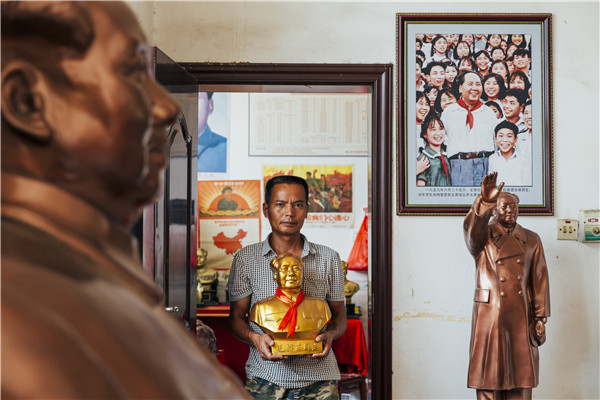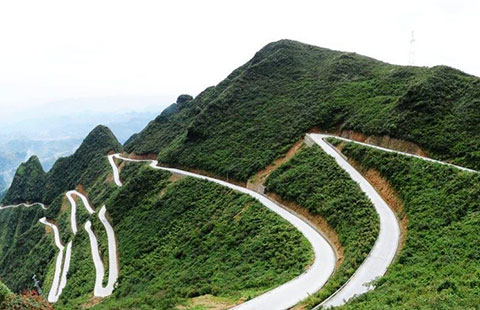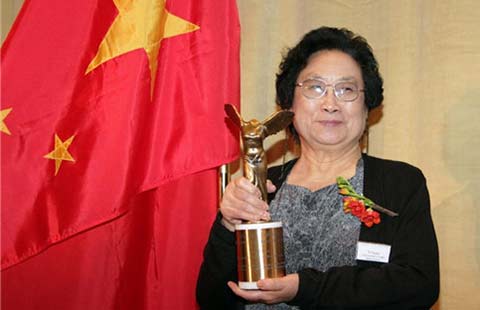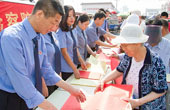'Red articles' continue to shine in modern era
By CANG WEI/FENG ZHIWEI (China Daily) Updated: 2015-10-01 06:57
 |
|
Tian Yongjun, who operates a souvenir store in Shaoshan, Hunan province, the hometown of Chairman Mao, says the most popular item is the bronze Mao bust. XU XIAOLIN/CHINA DAILY |
Zhang Deben, 63, established the Mao Zedong Exhibition Hall at No 68 Changming Road in Xi'an, Northwest China's Shaanxi province, to honor the memory of the chairman and some other pioneers in founding the New China.
Grateful that his tuition fees were waived by the government so he could attend primary and secondary school, Zhang has been collecting Mao memorabilia since he was a teenager.
After making a fortune in construction and renting out storehouses, he came up with the idea of opening a Mao museum to remind people of the Communist pioneers.
After spending more than 10 million yuan to collect the red articles, Zhang opened the museum in December 2007. In eight years, more than 300,000 people have made free visits to the museum, most of them students, Party members and government employees.
Among the red collections, Chairman Mao memorabilia, including badges, busts and copies of his quotations, are some of the most popular.
Industry emerges
Mao's hometown, Shaoshan, Hunan province, has developed an industry producing Mao sculptures since the leader's death in 1976, and thousands of local people have benefited.
Shaoshan has attracted millions of tourists. In December 2014, a high-speed railway connected the city to Changsha, the provincial capital. Disposable income per capita reached 18,588 yuan that year.
Sculptures of Mao are popular with tourists visiting Shaoshan. Prices of the most popular bronze busts or statues, depending on size, range from 399 yuan to 1,299 yuan. The prices of some big ones, which are custom made for schools and government organizations, are set by the local commodity pricing bureau.
Xie Jinshan, manager of a craft shop in Shaoshan who is in his 30s, said Mao statues are the most popular. The sales of his shop exceeds 1 million yuan a year, he said.
He covers each sculpture with red cloth when it is sold, not only to protect it from damage during transportation but to show his respect to the former leader.
"Sellers and buyers don't use the word 'buy'," Xie said. "Instead, we use the word 'invite', the same as we invite Buddha statues into our homes. ... Many people nowadays still appreciate what Mao did to liberate the country. The life of my family has improved greatly since I engaged in the industry 10 years ago."
He added that the sales of big statues, which are generally 1.83 meters tall, Mao's height, fell dramatically in 2015.
"Governmental organizations, which make up the majority of buyers, have cut their budgets due to the central government's anti-graft campaign. Many of them don't even distribute mooncakes to their employers for the Mid-Autumn Festival, let alone buy expensive bronze statues."
Ji Yucheng of the China Association of Collectors said that oil paintings and documents are among the most expensive items in the red collections.
One oil painting, Chairman Mao Goes to Anyuan by Liu Chunhua, was sold at auction for 6.05 million yuan in 1995.
An edition of Mao's quotations, published in 1944, is worth 180,000 yuan because few of them have appeared on the market.
Wen Xinzheng in Shaoshan contributed to this story
Contact the writers at cangwei@chinadaily.com.cn and fengzhiwei@chinadaily.com.cn
- Nanjing Massacre files inscribed on Memory of World Register
- Smoking may claim lives of 1 in 3 young Chinese men
- CPC expels media exec over UK 'green card'
- Overseas travel booms during 'golden week' holiday
- 'Queen of Ivory' faces charge in Tanzania
- China, US set ties 'in right direction'
- China's Forbidden City widens its reach to the public
- Leading aircraft manufacturer poised to export new fighter jet
- Fujian governor investigated for suspected disciplinary offenses
- Meeting on Taiwan affairs seen as a boost to relations







